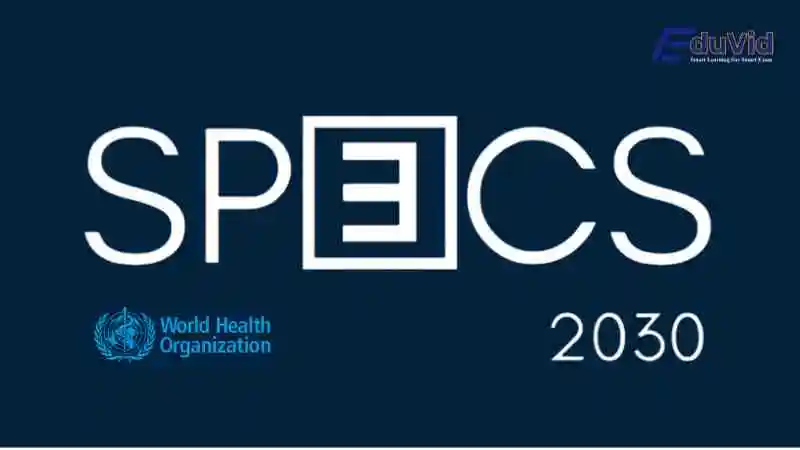The WHO SPECS 2030 initiative has been launched by the World Health Organization, marking a landmark new global effort to ensure everyone has access to affordable eyecare. This ambitious plan aims to assist at least 2.2 billion people living with vision impairment and blindness by the year 2030, providing a clear roadmap for integrating essential eye care into national health services worldwide.
This comprehensive guide breaks down the groundbreaking WHO SPECS 2030 initiative, its core goals, and its profound potential to change millions of lives for the better.
(Suggested Visual: A high-quality banner image showing a diverse group of people with clear vision smiling, with the SPECS 2030 logo overlaid).
The Growing Crisis of Global Vision Impairment
Before diving into the solution, it’s crucial to understand the scale of the problem. According to the WHO, at least 2.2 billion people have a near or distance vision impairment, and for almost half of these cases, the impairment could have been prevented or is yet to be addressed. The leading causes remain uncorrected refractive errors (the simple need for glasses) and cataracts.
The economic impact is staggering, with lost productivity due to vision impairment estimated to cost the global economy over $411 billion annually. This burden falls disproportionately on low- and middle-income countries, older populations, and rural communities, creating a cycle of poverty and inequality. It is this urgent global health challenge that the WHO SPECS 2030 initiative is designed to confront head-on.
What is the WHO SPECS 2030 Initiative?
The WHO SPECS 2030 initiative is a comprehensive global framework designed to support countries in achieving the eyecare targets outlined in the “World report on vision.” It provides a practical roadmap for governments to scale up services and embed eyecare within primary healthcare, making it a core component of Universal Health Coverage.
The name “SPECS” represents the five core pillars of the strategy:
- Surveillance: Gathering quality data on eyecare needs and services to inform policy.
- People-centred care: Ensuring eyecare services are accessible, affordable, and responsive to patient needs.
- Evidence-based practices: Implementing proven, effective, and cost-effective interventions.
- Collaboration and partnerships: Uniting governments, civil society, and the private sector.
- Systems and financing: Strengthening health systems to deliver eyecare sustainably.
Key Targets of the WHO SPECS 2030
The initiative sets two primary global targets to be achieved by 2030:
- A 40% increase in the effective coverage of refractive errors.
- A 30% increase in the effective coverage of cataract surgery.
Achieving these targets would represent one of the most significant public health victories of the decade.
Also Read: World Paper Bag Day 2025: Go Green, Choose Paper
How SPECS 2030 Aims to Achieve Its Goals
WHO SPECS 2030 moves beyond declarations to provide practical, actionable support. It focuses on empowering countries through several key mechanisms:
Role of Governments and Technology
The initiative calls on governments to develop and fund national eye health strategies. A major component is leveraging technology, such as promoting tele-ophthalmology for remote consultations and using AI-powered diagnostic tools to speed up screenings. It also aims to improve supply chains for affordable, high-quality spectacles.
Impact on Healthcare Providers and the Private Sector
SPECS 2030 emphasizes a collaborative public-private approach. It encourages partnerships with private sector ophthalmologists and optical businesses to expand service delivery. Crucially, it focuses on training primary healthcare workers to conduct basic vision screenings, identify problems early, and make appropriate referrals, thus integrating eye health into the broader health system.
The Road Ahead: Challenges and Opportunities
The path to achieving the goals of the WHO SPECS 2030 initiative is ambitious. Key challenges include a shortage of trained eyecare professionals, inadequate public health funding, and logistical hurdles in reaching remote populations.
However, the opportunities are immense. By embracing new technologies, fostering innovative public-private partnerships, and securing political commitment, the goals are within reach. This initiative represents a pivotal moment and a beacon of hope in the global fight against preventable blindness.
Frequently Asked Questions (FAQ)
1. Who will fund the WHO SPECS 2030 initiative? Funding is envisioned as a multi-stakeholder effort, combining increased domestic investment from national governments with support from international donors, development banks, and private sector partners.
2. How is this different from previous eyecare initiatives? The WHO SPECS 2030 initiative places a stronger emphasis on integrating eyecare into primary healthcare systems and Universal Health Coverage, rather than treating it as a separate, vertical program. It focuses on country-level implementation and data-driven accountability.
World Health Organization (WHO): The official press release or initiative page on https://www.who.int/
Important MCQs based on ‘WHO SPECS 2030’
Question 1: Recently, which international organization has launched a global initiative named ‘SPECS 2030’ to ensure universal eye care by 2030?
(a) United Nations (UN)
(b) World Health Organization (WHO)
(c) UNICEF
(d) World Bank
Answer: (b) World Health Organization (WHO) Explanation: The ‘SPECS 2030’ initiative was launched by the World Health Organization (WHO) to assist countries in integrating eye care into their national health services.
Question 2: Under the ‘SPECS 2030’ initiative, what is the targeted percentage increase in the effective coverage of cataract surgery by 2030?
(a) 20%
(b) 30%
(c) 40%
(d) 50%
Answer: (b) 30% Explanation: The initiative has two main targets: a 30% increase in the coverage of cataract surgery and a 40% increase in the coverage of refractive errors.
Question 3: In WHO’s SPECS 2030 initiative, what does ‘P’ stand for in the acronym ‘SPECS’?
(a) Policy
(b) Partnerships
(c) Primary
(d) People-centred care
Answer: (d) People-centred care Explanation: SPECS is an acronym for the five pillars of the strategy: Surveillance, People-centred care, Evidence-based practices, Collaboration and partnerships, and Systems and financing.
Question 4: What is the primary objective of the ‘WHO SPECS 2030’ initiative?
(a) To increase global vaccination coverage
(b) To create awareness for non-communicable diseases
(c) To ensure affordable care for people with vision impairment and blindness
(d) To reduce maternal and child mortality rates
Answer: (c) To ensure affordable care for people with vision impairment and blindness Explanation: The central goal of the initiative is to ensure that at least 2.2 billion people with vision impairment receive the essential and affordable eye care they need by 2030.
Question 5: The ‘SPECS’ initiative, launched by the World Health Organization, aims to achieve its set goals by which year?
(a) 2027
(b) 2030
(c) 2035
(d) 2040
Answer: (b) 2030 Explanation: The name of the initiative, ‘SPECS 2030’, directly indicates the timeline for achieving its goals, which is the year 2030.





